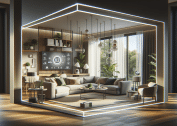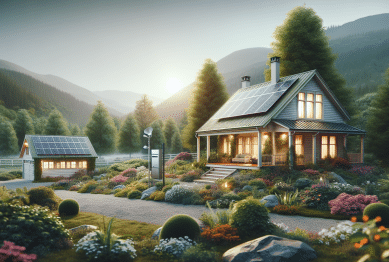Discover how small changes in home decor can create a big impact on everyday spaces. This guide explores budget-friendly trends, clever design strategies, and inspiring ways to refresh your home’s atmosphere, helping you personalize each room with style and creativity.
Why Personalizing Your Home Space Matters
The space you live in deeply affects how you feel. Personalizing your home can feel empowering, and embracing home decor ideas tailored to your tastes helps create a haven that truly represents you. Even minor choices, like selecting calming colors for the living room or introducing cozy textures in the bedroom, change the whole mood. Experts have found that environments designed with intention can reduce stress and prompt happiness. Placing a favorite print on the wall, adding a textured area rug, or displaying objects that tell your story add layers of meaning to daily life.
Expressing personality through decor design goes beyond following interior trends. Many people use artwork, accent furniture, or creative lighting to make rooms feel unique. These simple home improvements do not require extensive renovations. Small shifts such as re-arranging furniture for better flow or introducing greenery can positively influence daily routines. Emphasizing personalization means your home evolves as you do, matching your current lifestyle and aspirations. Every new piece—big or small—adds a touch of comfort that’s just for you.
Adding a personal touch might even boost productivity and relaxation. Research in environmental psychology suggests a strong bond between tailored spaces and overall wellbeing (https://www.apa.org/news/press/releases/2015/06/home-psychology). Decorative accents such as patterned cushions, signature scents, or curated photo displays make rooms feel like safe retreats. The act of updating your decor is itself a creative process that can lift spirits, providing a sense of accomplishment and pride in your surroundings.
Affordable Decor Swaps to Refresh Your Space
Redecorating doesn’t mean starting from scratch or making major purchases. There are countless affordable home decor swaps that give rooms a new lease on life. One easy trick is to switch out fabrics—think pillow covers, throws, or table runners. By seasonally rotating textiles, you can bring warmth in the winter and lightness in the summer. This approach lets you experiment with trending colors or playful patterns in a low-commitment way, offering variety without overhauling your style or budget.
Lighting is another high-impact, low-cost update. Swapping standard bulbs for soft white or Edison-style bulbs creates a cozy, ambient feel perfect for evenings at home. Positioning table lamps and candles strategically lets you shape the atmosphere for relaxation or productivity. Artistic lampshade choices—like natural fibers or geometric prints—add personality to overlooked corners, instantly elevating your living room or reading nook. These simple design tips can increase the sense of comfort and visual interest without significant investment.
Wall art transformations also offer great value. Gallery walls composed of personal photos, inexpensive prints, or DIY artwork can be updated as tastes evolve. Temporary wall decals and removable wallpaper provide color and whimsy for renters or anyone looking for a non-permanent transformation. Adding mirrors amplifies natural light and creates the perception of more space, especially in smaller rooms. These strategies blend creative expression with practicality, making it easy for everyone to explore their decorative preferences without commitment.
Clever Storage and Organization Techniques
An organized space feels more inviting and functional, and smart storage solutions can double as stylish home decor. Consider using decorative baskets, woven bins, or trunk-style coffee tables for concealed storage that enhances room aesthetics. Open shelving allows you to display treasured items while keeping essentials within reach. Incorporating multi-purpose furniture, such as ottomans with inner compartments, maximizes both function and visual appeal for any living environment.
Wall-mounted organizers, pegboards, and floating shelves make use of vertical areas often overlooked in decor planning. This technique is especially popular in small apartments and studios, allowing creative organization without crowding the floor. Clear jars in kitchens or labeled baskets in entryways keep daily items tidy. Thoughtful curation—rotating favorite books, ceramics, or plants—means each item has a purposeful role, preventing clutter and inviting calm into every corner.
Plan for flexibility too. Modular storage units and stackable drawers adapt as life changes, letting you reorganize swiftly for new hobbies or changing needs. Folding screens and room dividers can create zones in open layouts for added function and privacy. Organization is not just about hiding messes but highlighting the value of chosen objects. By integrating storage into your home decor plan, every room can become more peaceful and efficient without sacrificing style.
Popular Trends and Inspirations in Home Interiors
Keeping up with popular home interior trends offers fresh ideas without requiring strict adherence to passing fashions. For instance, the rise of biophilic design—integrating natural elements indoors—has led to increased use of houseplants, natural wood finishes, and earthy color palettes. Research suggests that exposure to greenery indoors supports emotional wellbeing and air quality (https://www.ncbi.nlm.nih.gov/pmc/articles/PMC4419447/). The trend is flexible: even a single potted plant or reclaimed wood shelf imparts a sense of tranquility and connection to nature.
Minimalism, another trend built for longevity, emphasizes decluttering and intentional choices. Streamlined furnishings in neutral tones, accented with organic textures, create calming visual harmony. This approach doesn’t require austerity—many decorators encourage blending minimalist backdrops with vibrant statement pieces. Using bold artwork, vintage finds, or patterned rugs against a quiet foundation allows self-expression without overwhelming the space, appealing to those who cherish balance and versatility in their homes.
Maximalism is also gaining traction for those who love color, pattern, and abundance. Layered textiles, curated collections, and playful wall colors bring energy to interiors. Both maximalist and minimalist trends can be adapted room by room, depending on how people want to feel in each space. Exploring inspiration from magazines, interior design websites, or virtual tours of iconic homes helps refine personal taste, encouraging creative exploration rather than strict rules.
Sustainable and Eco-friendly Decor Choices
Growing interest in sustainability has opened a world of eco-friendly home decor options. Choosing recycled materials, bamboo, rattan, or reclaimed wood reflects a commitment to minimizing environmental impact. Many homeowners now seek out secondhand furnishings, exploring thrift stores and online marketplaces for unique finds. Upcycling—giving discarded items new life as statement pieces—fosters creativity, reduces waste, and leads to one-of-a-kind decor solutions that truly stand out.
Non-toxic paints, organic fibers, and LED lighting are other accessible ways to create healthier homes. Consuming less but choosing better-quality items increases longevity and reduces resource strain. Seeking independent makers or ethical brands supports local communities and artisanal craftsmanship. In turn, these choices promote a story-driven approach to decorating, emphasizing values as much as visuals. Green initiatives align with bigger lifestyle changes, making decor part of a more holistic, environmentally minded life.
Energy-efficient practices, such as opening windows for airflow or arranging decor to maximize daylight, can reduce electricity demand. Opting for minimalist consumption—such as a capsule furniture collection—prevents overcrowding and extends the lifespan of favorite pieces. Across all budget levels, embracing sustainability provides numerous design options that are both stylish and responsible. Such approaches prove that eco-friendly living pairs with elegance and comfort in remarkable ways.
Making Your Decor Journey Enjoyable
Transforming a home doesn’t need to be stressful or costly. Starting with one room, surface, or color scheme makes the process manageable and enjoyable. Instead of aiming for overnight completion, focus on gradual updates and celebrate each completed corner. Home decor is a journey, not a race—and anyone can enjoy discovering what truly suits their tastes. Resources like online guides, style quizzes, and virtual mood boards add excitement and inspiration to the planning phase, making the creative experience interactive and rewarding.
Inviting others to share opinions or collaborate on projects can foster connection and encourage fresh perspectives. Many families or friends host DIY evenings or swap decor items for a change of scenery at no extra cost. Tracking before-and-after photos or journaling the evolution of your space also provides a sense of satisfaction as you watch your vision unfold. Joyful, intentional decorating isn’t about achieving perfection—it’s about crafting an environment that uplifts and welcomes, day after day.
Keep in mind: there are no fixed rules for what makes a home beautiful. What matters is creating spaces that nurture and empower those living in them. By focusing on functionality, comfort, and personal stories, you can cultivate atmospheres that provide refuge from the outside world. Decorating, at its core, is a way to celebrate individuality and make every room a personal testament to creativity and wellbeing.
References
1. American Psychological Association. (2015). The home and psychology. Retrieved from https://www.apa.org/news/press/releases/2015/06/home-psychology
2. National Institutes of Health. (2015). Health benefits of houseplants. Retrieved from https://www.ncbi.nlm.nih.gov/pmc/articles/PMC4419447/
3. Environmental Protection Agency. (n.d.). Sustainable materials management. Retrieved from https://www.epa.gov/smm
4. U.S. Department of Energy. (n.d.). LED lighting. Retrieved from https://www.energy.gov/energysaver/led-lighting
5. Harvard University. (n.d.). Psychology of spaces. Retrieved from https://hwpi.harvard.edu/designthinking/psychology-space
6. University of Minnesota. (n.d.). Sustainable home ideas. Retrieved from https://extension.umn.edu/green-living/sustainable-living-home









